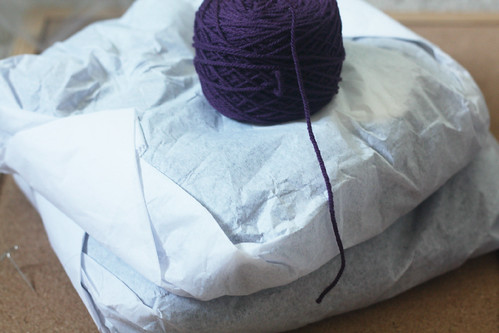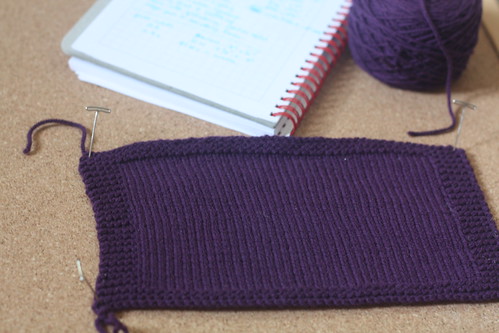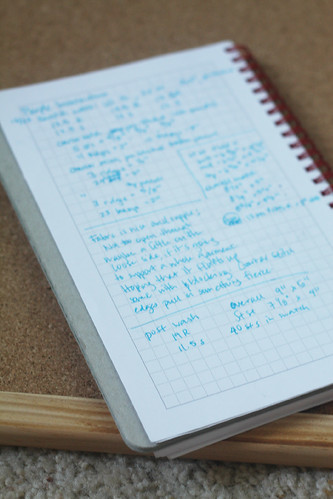Just to kick this off with a “…huh?” note, if you are me and you say the phrase “sketch and swatch” over and over in your head, as I was yesterday when jotting down notes for the blog, it starts to sound like some seriously weird Jane Fonda workout video where she’s knitting in one of those leotard things, and about which I would like to know nothing more.
After that kind of opening, a discussion about swatching can’t possibly seem that bad.
I’m sure you all know the standard procedure for swatching, even if you don’t actually do it (no judging, that’s why I try to knit sleeves first; they’re my swatch-in-progress). But in case anyone actually isn’t familiar with what a swatch is and why one “should” swatch, a brief rundown: a swatch is just a small piece of fabric, in this case a small piece of knitting that is done to check one’s gauge. This ensures that your project “should” be the desired size once it’s finished.
For this particular project, I was using a new-to-me yarn and trying to get a specific finished fabric, so swatching was incredibly important. I chose Quince & Co’s Chickadee yarn because it seemed like an incredibly affordable option, and came in this delicious purple color.
Chickadee is listed as a sport weight yarn, but as I played around with the skeins, it felt a little heavier to me. So I first swatched on US size 5 needles and this is what I ended up with.
Forty stitches on size 5s gave me a good sized swatch, with a fabric that was a little loose. But given the nature of the plies and the plumpness of the yarn when no tension was added to (aka, as it was in the skein or just lying about), I thought it would puff up a bit once it was washed, and it sure did. (This is why it’s important to wash swatches, too.) You can see the individual stitches, but when this fabric is held up to the light or stretched, it stays pretty solid (I wouldn’t recommend wearing knitwear without some sort of camisole under a top, anyway, as the oils in your skin will break down the proteins in the fabric faster, but you don’t want your camisole or tank to be peeking through, either).
All through the swatching process, I was taking notes. I noted the number of stitches I cast on, and then I measured the swatch in three different places once I had finished knitting it. I measured the overall swatch size in length, height, and my stitch and row counts. This may seem like overkill, but your knitting tension can vary within projects, even within twenty minutes of knitting, so again, I would recommend you go overboard with your measuring so you can find a fairly accurate average.
And then I washed the swatch and remeasured everything. As I expected the swatch did grow a little bit, but the stitch and row counts are where I saw the most difference—this is exactly what I wanted, as I wanted the fabric to be a bit more buff, but did not want the overall swatch to grow tremendously. I don’t remember what my original gauge was, but my final gauge was in the neighborhood of 11.5 sts and 19 rows to 4″.
But what does this all mean, Basil? This means that now we can do some algebra in the next post! ::watches all of her subscribers disappear into the ether::




lol not me! I’m sticking around for this (even if I sucked at math in all its forms)
Yay! Hopefully I can come up with a way to break this math down into super simple ideas, because understanding “knitting math” will make your knitting life so much easier in the long run. 🙂
I fear no math! Algebra, prepare to do your worst!
I hate swatching, but I’m enjoying “watching” your design process.
That’s the spirit!
I usually don’t like swatching either, but I’m sort of having an on-going “come to Jesus” moment where I realize that swatching is actually pretty darn helpful and keeps me from having sleeves that are 8″ too long (which is what happened with my Vivian cardigan, oops).
[…] week, we talked about that dreaded “s” word, swatching. Today we’re going to walk through taking data from a swatch and turning it into usable […]
[…] Jul Continuing on from the last three posts in this series (sketching, swatching, and measuring), today we’re going to talk a little bit about the construction and the start […]